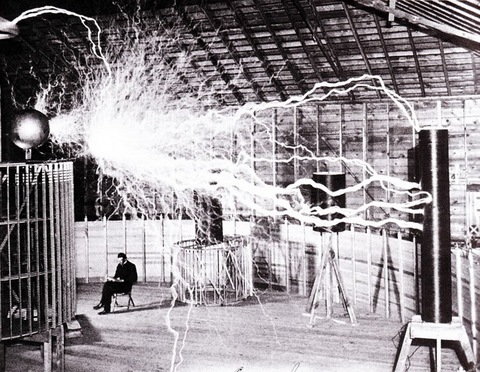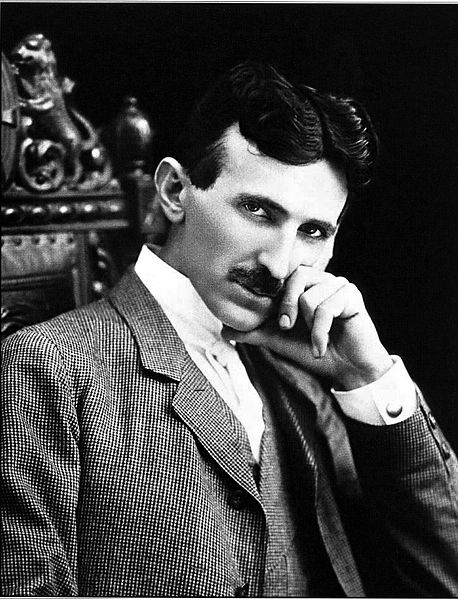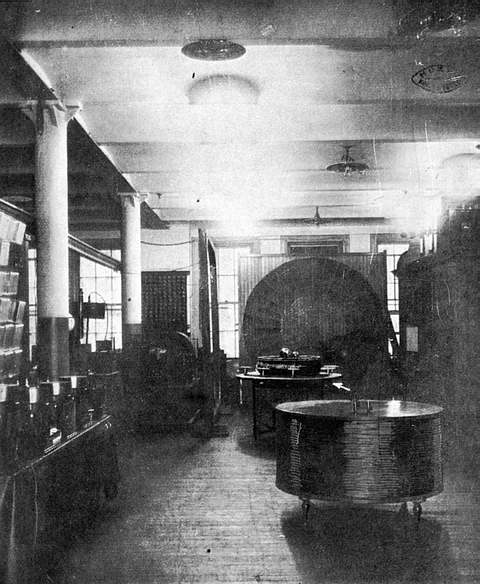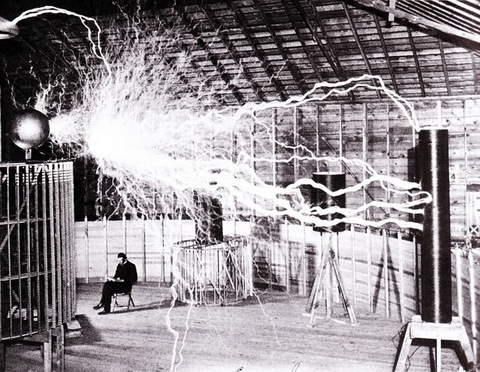Nikola Tesla (c. 1896) Courtesy of Wikipedia
Now here’s a different sort of SoHo story.
Tesla. Not the car company. Not the heavy metal band. The inventor, Nikola Tesla.
AC/DC. Not the heavy metal band. The battle over electrical standards between Nikola Tesla and Thomas Edison.
What does this have to do with SoHo? It turns out that Nikola Tesla had three laboratories located in the SoHo area: one at 175 Grand, one at 33-35 South Fifth Avenue (now called LaGuardia Place), and another at 46 East Houston Street. This was in the 1880’s and 1890’s, long before SoHo was SoHo, but it is a significant part of our area’s history in that Tesla was one of the most influential inventors of his time.
Born in 1856 in a small town in Croatia, Nikola Tesla was obsessed with electricity and came to the US in 1884 to work with Thomas Edison at his laboratory on the Lower East Side. The two did not get along—among other things, they had differing views about what the standard of electrical distribution should be. Edison, who had already invested heavily in a direct current system (DC), tried to prove that Tesla’s system of alternating current (AC) was dangerous, when, in fact, it was direct current that was not only inefficient, but deadly. Today, all household electricity is delivered via AC.
Nikola Tesla in front of the spiral coil of his high-frequency transformer at East Houston St., New York City..—Photographed by Tonnele & Co.” From “Tesla’s Important Advances,” Electrical Review, 20 May 1896, 263.
Tesla was also a visionary in wireless technology. It was in his Grand Street lab that he developed the high-voltage, high-frequency transformer called the Tesla Coil and then at his South Fifth Avenue lab that he experimented with wireless lighting, giving demonstrations to friends including the architect Stanford White and Mark Twain.
Tesla and Twain became close friends after, it is said, Tesla cured Twain of his chronic constipation by having him stand on an electric plate and running an electric charge though his body. The two men also purportedly took turns aiming Tesla’s X-ray “gun” at each other, making enormous x-rays of each other’s bodies and skulls in sheets of undeveloped film taped to the wall. Boys will be boys…
Main room of Tesla’s laboratory at East Houston Street. From World Mysteries Blog
After a fire in 1895 gutted his lab, Tesla fell into a depression that he overcame through electroshock treatment from his coils. His friends got together to raise funds for him to open a new lab on Houston Street, where he began developing a wireless system for transmitting power around the world.
Tesla soon moved on, relocating to the vast open spaces of Colorado for a while before returning to New York to work on further inventions, including wireless radio wave transmission as well as the preliminary design of a handheld receiver that could receive news, telephone messages, and telegrams. It seems fitting that the Apple Store on Prince Street, temple of the iPhone, is located just blocks away from the place it was first conceived.
Nikola Tesla embodied the true spirit of invention. He was a “mad scientist” to whom inventions appeared as fully formed visions that swirled above his head. He was not, however, a great capitalist, often not protecting his patents and therefore not getting due credit for his ideas. He also suffered from extreme phobias and obsessions. He would suddenly become immobile, freezing up unable to move or speak, and he as also had an inexplicable aversion to pearls and was an extreme germaphobe, though he loved New York City pigeons, inviting them to roost on his windowsill and in his room at the Hotel New Yorker on 34th Street.
This tesla coil snuffed out the power in Colorado Springs when this photo was taken. Photo by Dickenson V. Alley, photographer at the Century Magazines via Wikimedia Commons
Nikola Tesla died in his sleep, alone and penniless, in January 1943. His influence is present each time we turn on our lights, yet he has been all but forgotten, unlike his peers, namely, Thomas Edison, known to all as the father of electricity, and Guglielmo Marconi, known as the inventor of radio. In recent years, Tesla fans have attempted to right this wrong. The Tesla Science Center at Wardenclyffe is raising funds to develop Tesla’s last and only existing laboratory in Shoreham, NY into a science and technology center. In addition, the exhibition “Tesla’s Wonderful World of Electricity” is currently on view at the New York Hall of Science.
Learn more about Nikola Tesla here:
“Introducing Nikola Tesla” on WNYC’s Studio 360
8 Things You Didn’t Know About Nikola Tesla at pbs.org
Imagining Nikola Tesla Samantha Hunt, author of
The Invention of Everything Else, a novel about Nikola Tesla, on WNYC’s The Leonard Lopate Show
“Places of Invention: Nikola Tesla’s Life” in New York Gotham History Blotter
“Tesla’s Wonderful World of Electricity” an exhibition at the New York Hall of Science





